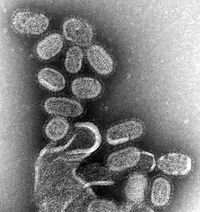
Photo from wikipedia
Favipiravir (brand name Avigan), a widely known anti‐influenza prodrug, is metabolized by endogenous enzymes of host cells to generate the active form, which exerts inhibition of viral RNA‐dependent RNA polymerase… Click to show full abstract
Favipiravir (brand name Avigan), a widely known anti‐influenza prodrug, is metabolized by endogenous enzymes of host cells to generate the active form, which exerts inhibition of viral RNA‐dependent RNA polymerase activity; first, favipiravir is converted to its phosphoribosylated form, favipiravir‐ribofuranosyl‐5′‐monophosphate (favipiravir‐RMP), by hypoxanthine‐guanine phosphoribosyltransferase (HGPRT). Because this phosphoribosylation reaction is the rate‐determining step in the generation of the active metabolite, quantitative and real‐time monitoring of the HGPRT‐catalyzed reaction is essential to understanding the pharmacokinetics of favipiravir. However, assay methods enabling such monitoring have not been established. 19F‐ or 31P‐based nuclear magnetic resonance (NMR) are powerful techniques for observation of intermolecular interactions, chemical reactions, and metabolism of molecules of interest, given that NMR signals of the heteronuclei sensitively reflect changes in the chemical environment of these moieties. Here, we demonstrated direct, sensitive, target‐selective, nondestructive, and real‐time observation of HGPRT‐catalyzed conversion of favipiravir to favipiravir‐RMP by performing time‐lapse 19F‐NMR monitoring of the fluorine atom of favipiravir. In addition, we showed that 31P‐NMR can be used for real‐time observation of the identical reaction by monitoring phosphorus atoms of the phosphoribosyl group of favipiravir‐RMP and of the pyrophosphate product of that reaction. Furthermore, we demonstrated that NMR approaches permit the determination of general parameters of enzymatic activity such as Vmax and Km. This method not only can be widely employed in enzyme assays, but also may be of use in the screening and development of new favipiravir‐analog antiviral prodrugs that can be phosphoribosylated more efficiently by HGPRT, which would increase the intracellular concentration of the drug's active form. The techniques demonstrated in this study would allow more detailed investigation of the pharmacokinetics of fluorinated drugs, and might significantly contribute to opening new avenues for widespread pharmaceutical studies.
Journal Title: NMR in Biomedicine
Year Published: 2022
Link to full text (if available)
Share on Social Media: Sign Up to like & get
recommendations!